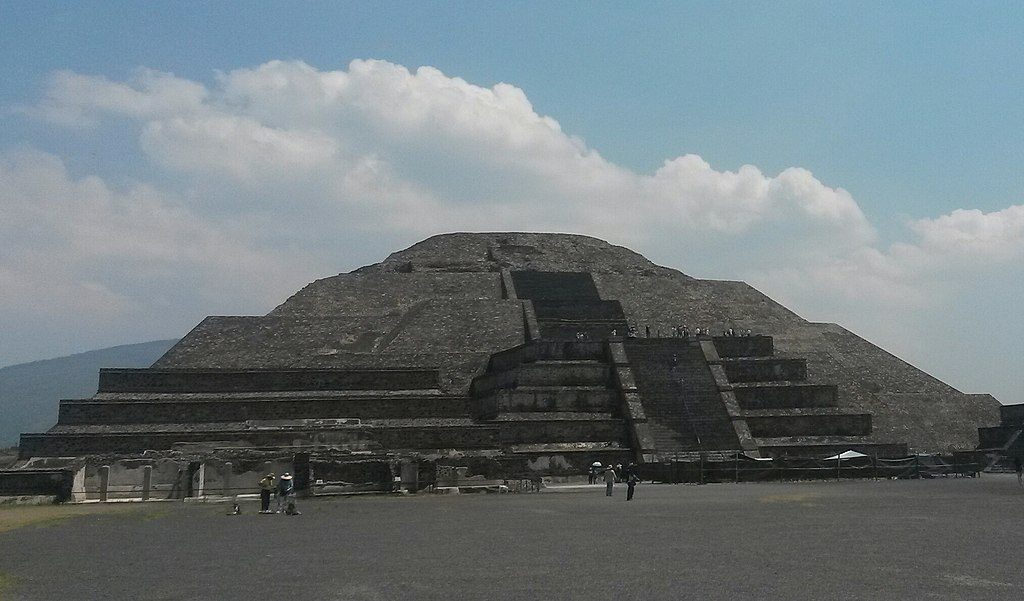At the heart of the mighty Aztec empire laid the capital Tenochtitlan, the Venice of the new world. No other civilization at the time could hope to compare to the city’s impressive pyramids, glamorous temples, and advanced aqueducts. At one point in history, Tenochtitlan was so populous that it contained around 200,000 inhabitants. But Tenochtitlan wasn’t always such a powerful urban site. When the Aztecs were immigrants looking for a new home, they were captivated by a mysterious ancient city. To this day, no one really knows who built it or what happened to its inhabitants. But to the Aztecs, they believed that out of this city emerged the whole of human society and order. This once glorious city was known as Teotihuacán.

There is only a minuscule amount of knowledge about Teotihuacán because a sufficient written record of the city does not exist. In fact, no one knows what the people of Teotihuacán called themselves or what the actual name of the city was. Indeed, it wasn’t until much later that the Aztecs named it Teotihuacán, which means “city of the gods.”1 To an extent, the Aztecs were not exaggerating, because Teotihuacán was once an electrifying center for religion, trade, and culture. At one point, the city contained over 2,000 apartment buildings, 600 pyramids, around 500 workshops, and countless temples, plazas, and palaces.2 But how, exactly, did Teotihuacán become such a powerful metropolis? Once again, let us look at what the Aztecs themselves have to say about it.
According to an Aztec legend, the world was created and destroyed four times before the creation of our current world. Each time the world was destroyed, the sun quickly perished alongside it, and a new sun, presided by a god, was required to create another world.3 The first world was under the dominion of Tezcatlipoca–the god of the night. During his era as the sun, there were no humans, but rather a race of vegetarian giants that roamed the Earth. Tezcatlipoca’s reign lasted for 676 years, but it was cut short when Quetzalcoatl, the god of the wind, grew displeased as he saw the other deity ruling above the land. So he used his staff to knock down Tezcatlipoca into the seas at the farthest corners of the earth. Angered by this, Tezcatlipoca gathered his strength and emerged from the water as a powerful jaguar, running through the Mesoamerican plains and mountains. Soon, many jaguars appeared alongside him, and they eventually hunted and killed every giant on Earth–thus bringing an end to the first world.4
Quetzalcoatl then presided over the second world and, under his rule, human-like beings began to appear. His reign was only 364 years long, however, for Tezcatlipoca wanted revenge on his cosmic rival. Using his dark powers to overwhelm the wind god, he launched a massive hurricane that swept away the sun and the people. Darkness then covered the world and the survivors hid in the trees, eventually turning into monkeys.5

Tlaloc, the rain god, found opportunity in the darkness, and quickly took charge over the new third world. Much to Tlaloc’s dismay, Quetzalcoatl was displeased with his rule, and he sent a rain of fire that again destroyed the sun and earth. The survivors who hid from the fire became the ancestors of the dogs, turkeys, and butterflies of today. The goddess of the lakes and oceans, known as Chalchiúhtlicue, then presided over the fourth sun and world. Although her reign lasted much longer than the previous two, tragedy was no stranger to the gods. Although no one knows exactly how the fourth world ended, Aztec accounts seem to tell the story of a great flood covering the Earth, turning the inhabitants of that world into fish, whales, and other creatures of the deep ocean.6
After some time, all the gods gathered at Teotihuacán. The earth was filled with darkness and a new sun was needed. The gods also decided that a moon should provide light when the sun did not. The rich god Tecuciztécatl proudly stepped forth to be the new sun. But a small, humbler god, Nanahuatzin also volunteered. After agreeing to share the Earth, the two made preparations to renew the world.7 For four days, Tecuciztécatl and Nanahuatzin prayed and fasted.8 When they finished, the other gods lit a great fire on the hard earth of Teotihuacán. In his lavish robes, Tecuciztécatl threw valuable quetzal feathers, stone flints, and incense into the fire as sacrifices. Nanahuatzin, having no riches to sacrifice, humbly offered weeds drenched in his own blood. The two slowly then approached the menacing flames of the fire. Tecuciztécatl intended to go first but he was ultimately driven back by the heat of the inferno. He approached it again for the second time… the third… the fourth. No matter what he did, the rich god was being held back by his fear. Then Nanahuatzin stepped forward. With his eyes closed and mind stilled, Nanahuatzin leapt into the great fire. Having been awestruck by his rival, Tecuciztécatl quickly rushed into the flames. Nanahuatzin then became the new sun, while Tecuciztécatl became the moon.9

The gods then waited for the new world to develop. However, after a while, the gods noticed that nothing was happening. Why wasn’t the new sun in motion? Why hadn’t the world been fully restored? After a discussion with Nanahuatzin, the rest of the gods then threw themselves into the fire, one by one, to restart the world. After all the gods sacrificed themselves, the age of the fifth sun began, and the world was now in motion. It was then, that out of Teotihuacán human society was born. The city flourished under the leaders and priests of Teotihuacán and it is said that after their deaths the pyramids of the sun and moon were built by giants.10
Though we may never know how this city actually came to be, it is no mystery that Teotihuacán was once a revered city in Mesoamerica. To this day, many visit the ruins of Teotihuacán and observe its sites, such as the “Avenue of the Dead,” a two-mile road that connects the Pyramid of the Moon to a large market. Other wonders include the towering Pyramid of the Sun, which was once a revered ritual site because it was built over a cave that many once believed was the place where humans emerged into the world.11 Some of the palaces and temples still stand today, such as the famed temple of Quetzalcoatl. While Teotihuacán may have a murky history, its name continues to stand against the sands of time, eternally offering its mysterious beauty to curious observers everywhere who yearn to learn more of humanity’s past.
- Early Civilizations in the Americas Reference Library, 2005, s.v. “Teotihuacán,” by Sonia G. Benson. ↵
- Charles Phillips, Aztec and Maya: The Complete Illustrated History: The Greatest Civilizations of Ancient Central America with 1000 Photographs, Paintings and Maps (New York: Metro Books, 2008), 55. ↵
- Early Civilizations in the Americas Reference Library, 2005, s.v. “Teotihuacán,” by Sonia G. Benson. ↵
- Charles Phillips, Aztec and Maya: The Complete Illustrated History: The Greatest Civilizations of Ancient Central America with 1000 Photographs, Paintings and Maps (New York: Metro Books, 2008), 160. ↵
- Charles Phillips, Aztec and Maya: The Complete Illustrated History: The Greatest Civilizations of Ancient Central America with 1000 Photographs, Paintings and Maps (New York: Metro Books, 2008), 160. ↵
- Charles Phillips, Aztec and Maya: The Complete Illustrated History: The Greatest Civilizations of Ancient Central America with 1000 Photographs, Paintings and Maps (New York: Metro Books, 2008), 161. ↵
- Charles Phillips, Aztec and Maya: The Complete Illustrated History: The Greatest Civilizations of Ancient Central America with 1000 Photographs, Paintings and Maps (New York: Metro Books, 2008), 161. ↵
- Early Civilizations in the Americas Reference Library, 2005, s.v. “Teotihuacán,” by Sonia G. Benson. ↵
- Charles Phillips, Aztec and Maya: The Complete Illustrated History: The Greatest Civilizations of Ancient Central America with 1000 Photographs, Paintings and Maps (New York: Metro Books, 2008), 162. ↵
- Early Civilizations in the Americas Reference Library, 2005, s.v. “Teotihuacán,” by Sonia G. Benson. ↵
- World History Encyclopedia, 2011, s.v. “The Teotihuacan Empire, 300–650 CE,” by Alfred J. Andrea. ↵




102 comments
Yousef Alghamdi
I have enjoyed the story of Tenochtitlan because of the way you are explaining it. The article was well written and inflow. I like the way you explained the restoration of the earth four times. When all gods gathered in Tenochtitlan and decided to have a new moon and sun to prevent the darkness of the earth, I felt that such a legend should be taught even though we have no sufficient written record. This article has opened my eyes to a new era that I am excited to search deeper into it.
Jonathan Ornelaz
Alexander,
I thought your article on the Tenochititlan people was very fascinating. You were able to tell the mystery of the land might have become a legend. Like you expressed there is no way of really knowing, because there is no accurate written record, but to think that there were these gods who fought among themselves and every time they thought they had the perfect setup one of the other gods did not like it and destroyed it. It was not until they finally realized that they all need each other to keep the world in balance that they all sacrificed themselves to make a great land that the people were successful and were able to build their lives up and thrive.
Eva Lizarraga
This article was well-written and had me intrigued! I had never even heard of the city of Tenochtitlan, so reading about the gods and myths that align with what was happening historically was especially interesting. It’s crazy that there isn’t much written information about the city, despite it being a center of religion, trade, and culture, as you’d think we’d have more evidence of what the city/people were like.
Evangelina Villegas
This article was simply amazing and the way the story was written was really good as it made me keep reading. The thing that I liked the most about this story was the beliefs the Aztecs had on the creation of the city of Teotihuacan. It was interesting to learn the supposed backstory of how the world was created and destroyed 4 times by the Gods in Aztec culture. It was a really nice touch on including the different personalities of each god, it made the gods appear more real than just being legends.
Rana
very specific, like those who hid from the rage of Quetzalcoatl became the ancestors of the dogs, turkeys, and butterflies of today. I do not know how any of those are really related, but I do know that it must be from someone’s very imaginative mind.
Nicholas Van Steenberg
I love the rich history and culture of the Aztecs, so this was a great read. I had never heard Teotihuacan’s full story in that much detail before; I had no idea they had such concrete details for their backstory. It is crazy to know that they were able to formulate this legend by just experiencing the world around them—great job with the research and wonderful writing.
Jake Faryniarz
This article was very informative on the beliefs the Aztecs created about the city of Teotihuacan. I never knew the Aztecs were able to come up with such an in depth legend on how the world was created and destroyed 4 times by the Gods. This story helps show how the Aztecs perceived life and religion during their time period. Legends like this can help give information about the people that came up with it. Even if the legends aren’t true it is a legend that was passed down through their religion and shaped who the Aztecs were.
Franchesca Baldwin
I liked the way this was written as a story. I think it’s very important to analyze myths and legends of civilizations in order to better understand their every day lives, as well as their systems. While the act of human sacrifice May seem (Justifiably) horrifying to the modern person, To the ancient people of Mesoamerica it was simply a way of life and completely necessary. They were created from bloodshed, And so must return to bloodshed.
Mia Hernandez
I enjoyed reading this article because it was so interesting. It is crazy that there is no recorded history because they passed down so many traditions and beliefs. It is quite the mystery but it is a great thing that the Aztecs stumbled across it. The details of each belief give the reader a better perspective on their life and it is very interesting. I enjoy being able to see the advancements throughout the years because we see how their living as impacted us.
Alyssa Ramos
It fascinates me that such an amazing city has such a mysterious past with no recorded history. I enjoyed reading about the various gods and Aztec legends. The world being created and destroyed four times was interesting to read about. I wonder how they came up with these stories about their gods and the creation of the Earth. We have come such a long way in religion and beliefs since then, and nowadays we have scientists to help discover the true origin of the Earth.
Carlos Serna
Wow! I forgot about how amazing this story was. I remember when I had History class in Mexico when I was a child and study the legends about the Aztecs, the Mexicas, and the Mayans. I believe that is important for the cultures to know about the legends of their ancestors because is part of their story. Anyway, every culture has a different legend to tell.